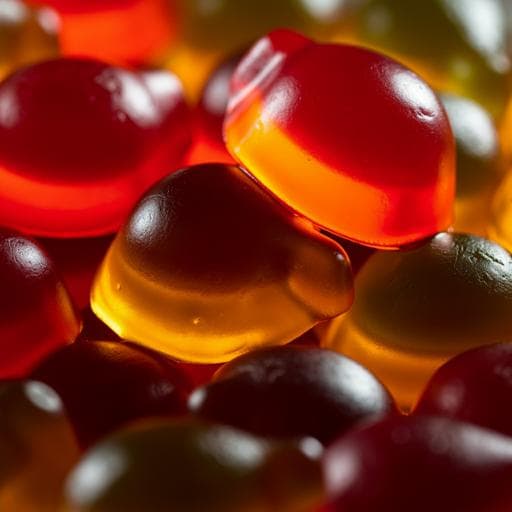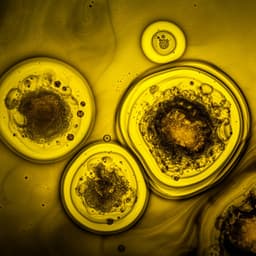
Food Science and Technology
Enhancing composition and functionality of jelly candies through apple and beetroot pomace flour addition
S. Gorjanović, S. Zlatanović, et al.
This innovative study investigates how jelly candies can be enriched with apple and beetroot pomace flour, boosting their dietary fiber and antioxidant content. The research led by Stanislava Gorjanović and colleagues reveals that these jelly candies not only taste great but also help reduce postprandial glucose levels, making them a delicious and functional option. Discover the future of healthier confectionery with optimized jelly candies derived from upcycled materials!
~3 min • Beginner • English
Introduction
The study addresses the challenge of low dietary fiber (DF) and dietary phenolics (DP) intake in modern diets and their linkage to non-communicable diseases, obesity, and diabetes. Fruit and vegetable pomace—rich in DF and DP—offers a low-energy, functional ingredient by reintroducing valuable by-products from juice production into foods. Newly developed technologies enable stable apple and beetroot pomace flours (APF, BPF) with preserved bioactives. Prior studies reported APF/BPF improved glycemia, glucose tolerance, and weight gain in animal models and enhanced DF/DP content in foods. The research objective was to develop innovative jelly candies using three common gelling agents (agar, pectin, gelatin) enriched with APF or BPF to improve nutritional quality (higher DF/DP, lower carbohydrate-to-fiber ratio), maintain desirable sensory and texture properties, and assess bioactive bioavailability/retention and effects on postprandial glucose, glycemic index (GI), and glycemic load (GL).
Literature Review
Prior formulations incorporated individual apple-derived biomolecules in pectin gels to target diabetes/obesity and combined beetroot pulp or pomace extracts with other ingredients in candies. Many enrichment attempts used extracts (e.g., rosemary, propolis, pomegranate) with high antioxidant activity but limited scalability and lacked long-term stability data. DF-enriched jellies using fibers from apple, bamboo, psyllium, and wheat achieved "source of fiber" claims, though syneresis and storage stability varied. Betalain use in candies improved color/antioxidant properties, but long-term storage stability of betalains in gels was seldom assessed. The carbohydrate-to-fiber ratio (10:1) has been proposed as a simple metric to guide healthier processed foods, yet it has rarely been applied to confectionery transformation. This study advances the field by directly incorporating minimally processed whole pomace flours (APF/BPF) into natural jelly matrices without synthetic additives, targeting improved DF/DP delivery, stability, sensory quality, and reduced GI/GL.
Methodology
- Flour preparation: Apple and beetroot pomace (industrial by-products) were dehydrated at ≤55 °C, ground (<300 µm), yielding APF and BPF with moisture 4–8% and water activity 0.2–0.4.
- Experimental design: Nine batches: three gelling agents (agar, pectin, gelatin) × three enrichment levels (control without flour; with APF; with BPF). Samples coded A, P, G (controls); A-APF, A-BPF; P-APF, P-BPF; G-APF, G-BPF.
- Jelly production: Gelling agent-specific pre-cooking steps (agar dissolved in juice; pectin added as dry mix with sucrose; gelatin allowed to swell). APF/BPF dispersed in apple juice; sucrose added. Cooked to ~75% dry matter, acidified with 0.57–0.65% 50% w/w citric acid, molded, cooled, refrigerated at 4 °C ≥24 h, cut, and coated with APF instead of sugar before packaging in glass jars.
- Proximate analysis: AOAC methods for moisture, protein, fat, ash; total carbohydrates by difference; sugars (glucose, fructose, sucrose) enzymatically (R-Biopharm kits); total, soluble, and insoluble fiber (AOAC 991.43); cellulose (SRPS ISO 6541:1997); fructans (AOAC 999.03); water activity at 25±2 °C.
- In vitro digestion: INFOGEST static model simulating oral, gastric, and intestinal phases applied to fresh and 9-month stored jellies (n=3 per sample) and flours. Bioaccessible supernatants were collected post-intestinal phase.
- Bioactives and antioxidant activity: Total phenolics (Folin–Ciocalteu; mg GAE/g), total flavonoids (colorimetric, mg catechin eq/g), betacyanins and betaxanthins (spectrophotometric quantification at 538/480 nm; µg/g), antioxidant activity by DPPH and FRAP (mmol Trolox eq/g).
- Sensory analysis: Eight trained assessors (ISO 8586:2023) evaluated appearance, texture, odor, taste, and overall score (1–5) shortly after production and after 9 months; three-way ANOVA evaluated effects of Pomace Flour, Gelling Agent, Time.
- Texture profile analysis (TPA): TA.XT Plus analyzer; cylindrical samples (12 mm × 10 mm), 50% deformation, probe P/25 mm; parameters: hardness (g), springiness, cohesiveness.
- In vivo glycemic testing: Prospective crossover per ISO 26642:2010 in 10 healthy adults (BMI 19–22 kg/m², fasting glucose ≤6 mmol/L), fasting ≥12 h, standardized conditions. Tested 25 g portions of pectin-based jellies (P, P-APF, P-BPF) for postprandial glucose curves (0–120 min) and IAUC; GI assessed using portions containing 25 g available carbohydrates compared to 25 g glucose; GL calculated as GI × available carbohydrate/100. Ethics approval: Institute of Public Health of RS (No. 5646/1, 07.10.2022).
- Statistics: XLSTAT; means ± SD; t-test and ANOVA with Tukey’s HSD (p<0.05).
Key Findings
- Pomace flours: APF and BPF were rich in DF (APF total fiber ~30.1 g/100 g; BPF ~26.7 g/100 g) with low fat (~0.6%) and moderate protein (APF 6.6%, BPF 12.0%).
- Proximate composition of jellies: Enriched jellies (all gelling agents) achieved DF >3 g/100 g (e.g., total fiber: G-APF 3.7; G-BPF 4.3; A-APF 4.1; A-BPF 4.4; P-APF 4.5; P-BPF 4.9 g/100 g). Moisture increased to ~20–22% vs controls (4–7%).
- Carbohydrate-to-fiber ratio: Controls had high ratios: gelatin 379, agar 134, pectin 37. APF/BPF incorporation reduced ratios to 19–15 across all matrices, corresponding to reductions of ~95% (gelatin), ~87% (agar), and ~60% (pectin) relative to controls. Although above the 10:1 recommendation, the reductions indicate substantial nutritional improvement.
- Phenolics, flavonoids, and antioxidant activity (upon in vitro digestion, fresh samples): Marked increases vs controls. Representative values:
• Gelatin matrix: TPC (µg GAE/g): G 564±29; G-APF 1153±133; G-BPF 1476±83. TFC (µg QE/g): G 289±23; G-APF 1464±83; G-BPF 1576±61. FRAP (mmol TE/g): G 1.19±0.15; G-APF 3.11±0.21; G-BPF 3.62±0.23. DPPH (mmol TE/g): G 1.47±0.31; G-APF 3.86±0.41; G-BPF 4.16±0.47.
• Agar matrix: TPC: A 255±12; A-APF 614±28; A-BPF 825±18. TFC: A 195±10; A-APF 1242±67; A-BPF 1125±49. FRAP: A 0.70±0.13; A-APF 2.30±0.24; A-BPF 2.50±0.14. DPPH: A 0.67±0.19; A-APF 2.56±0.28; A-BPF 2.60±0.34.
• Pectin matrix: TPC: P 247±13; P-APF 810±4; P-BPF 869±20. TFC: P 228±30; P-APF 1520±65; P-BPF 1575±73. FRAP: P 0.70±0.18; P-APF 2.72±0.28; P-BPF 3.03±0.20. DPPH: P 0.80±0.19; P-APF 2.99±0.28; P-BPF 3.42±0.38.
- Storage stability (9 months): Despite statistically significant decreases, TPC, TFC, FRAP, and DPPH remained high with good retention across matrices. Betalains in BPF jellies showed good retention: e.g., betacyanins (µg/g) G-BPF 99.7→99.5 (ns), A-BPF 101.9→91.3, P-BPF 102.7→89.2; betaxanthins G-BPF 76.7→72.8, A-BPF 61.3→55.6, P-BPF 69.1→64.1.
- Sensory evaluation: All enriched samples were acceptable and stable over storage. Pectin-based jellies (P-APF, P-BPF) achieved top taste scores (P-APF: 4.88→4.44; P-BPF: 4.50→3.84 from 0 to 9 months) and favorable texture, leading to their selection for in vivo testing.
- Texture: Matrix-dependent effects observed. Pectin jellies exhibited higher hardness (P 1660±80→1485±276 g; P-APF 1767±224→1625±246 g). Agar samples decreased in hardness over storage (A 1486±141→1021±73 g; A-BPF 1110±109→834±31 g). Gelatin samples showed lower hardness (~500 g range) with higher springiness/cohesiveness; pomace addition slightly reduced cohesiveness in non-gelatin matrices. Statistical analyses indicated significant factor effects for multiple TPA parameters.
- Postprandial glucose, GI, and GL (in vivo, pectin jellies): Enriched jellies (P-APF, P-BPF) yielded lower and steadier glucose curves vs control P, with peak at ~30 min notably reduced. IAUC decreased by approximately 50% vs control. Both P-APF and P-BPF were classified as low-GI foods (GI <55) with low glycemic load, supporting higher intake allowances compared to conventional candies.
Discussion
The study demonstrates that minimally processed apple and beetroot pomace flours can be directly integrated into natural jelly candy matrices (agar, pectin, gelatin) to substantially enhance dietary fiber and bioactive content while maintaining acceptable sensory and textural qualities. The marked reductions in carbohydrate-to-fiber ratios and increases in bioaccessible phenolics, flavonoids, and antioxidant capacity address the primary aim of improving nutritional quality of confectionery. Bioactive retention during 9 months of storage, including stable betalains in BPF jellies, supports shelf-life feasibility. In vivo findings with pectin-based jellies confirm functional benefits: significantly reduced postprandial glycemia, low GI (<55), and low GL, consistent with mechanistic roles of fiber (increasing viscosity, slowing glucose absorption) and polyphenols/betalains (modulating carbohydrate digestion and insulin sensitivity). Collectively, these results validate jelly candies as effective carriers for delivering DF and DPs from upcycled pomace, aligning with obesity and diabetes prevention strategies and circular economy goals.
Conclusion
This work introduces compositionally optimized jelly candies enriched with apple and beetroot pomace flours that: (1) significantly improve DF content and lower carbohydrate-to-fiber ratios; (2) elevate bioaccessible phenolics, flavonoids, and antioxidant activity with good 9-month retention; (3) maintain consumer-acceptable sensory and texture profiles; and (4) reduce postprandial glucose response, achieving low GI and GL classifications. These innovations demonstrate a scalable pathway to transform energy-dense confectionery into functional foods using upcycled ingredients. Future research should focus on product diversification (e.g., sugar replacement strategies), testing across broader consumer populations (including individuals with metabolic disorders), optimization of gelling systems for texture and syneresis control, and expanded shelf-life and real-world consumption studies.
Limitations
- In vivo testing was conducted only on pectin-based jellies and in a small cohort of healthy adults (n=10), limiting generalizability to other matrices and populations (e.g., individuals with diabetes or different BMIs).
- GI/GL assessments were limited in scope (single product type per matrix for in vivo; crossover design but modest sample size).
- Bioactive and antioxidant measurements relied on in vitro digestion models which, while standardized (INFOGEST), may not fully replicate in vivo bioavailability and metabolism.
- Long-term storage evaluation was 9 months; longer durations and diverse storage conditions were not assessed.
- Sensory evaluation used a trained panel (n=8); broader consumer acceptance testing was not reported.
Related Publications
Explore these studies to deepen your understanding of the subject.







